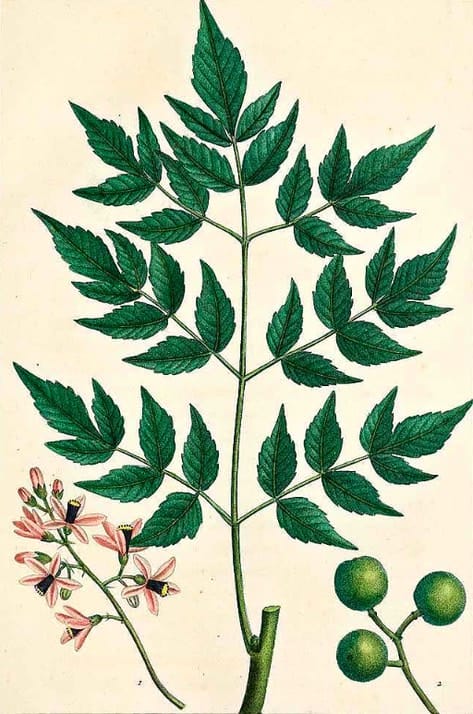Melia toosenden, Chuan Lian Zi 川楝子Sichuan Chinaberry, Sichuan Pagoda TreeChuan Lian Zi (TCM) Fruit of M. azedarach is called Ku Lian Zi. |

|
 Melia azedarach, which is stated to be a synonym for M. toosenden
Melia azedarach, which is stated to be a synonym for M. toosendenMichaux, F.A., The North American sylva, vol. 3 (1819)
Botanical name:
Melia toosenden and M. azedarach were originally regarded as synonymous in older TCM texts. Bensky lists the latter as an adulterant for the fruit, while listing both as a source for the bark. We have listed M. azedarach as a separate entry (Azadirachta, Neem) but they may be medicinally synonymous.
Chen & Chen (2001) state that the fruit of M. azedarach (Ku Lian Zi) is used in some parts of China synonomously with Chuan Lian Zi. However, the fruit of M. azedarach (Ku Lian Zi) is Bitter and more toxic than Chuan Lian Zi. If used instead of Chuan Lian Zi the dose should be reduced. As little as 10 pieces (though usually up to 70 pieces) of the fruit of M. azedarach (Ku Lian Zi) may cause signs of toxicity.
Parts used:
Fruit
Temperature & Taste:
Cold, dry. Bitter. Slightly Toxic
Uses:
1. Moves the Liver Qi, Eases Pain:
-Liver Qi stagnation, pain and tension in the chest and ribs; Stomach disharmony
-Gall Stones
-Hernia associated with Qi stagnation
-Menstrual pain associated with Liver Qi stagnation (emotions)
-usually used for cases with Heat, but with suitable herbs it can be used for Cold disorders also
-it has demonstrated anti-cancer activity so may be used in cases with Qi stagnation
2. Clears Heat:
-“good for treating acute febrile disease and that caused by Cold with high fever, restlessness and mania” (Shen Nong Ben Cao Jing)
-“It brings down high fever with mania, irritation and stuffiness. Stew the drug to make a decoction. Bathe the patient with the decoction. Do not take it”. (Zhen Quan)
-“good for treating colic with cold extremities due to pent-up pathogenic Heat. It is the only drug that works effectively in the treatment of such disease”. (Zheng Yuan Su)
3. Kills Worms and Parasites:
-Roundworm, Tapeworm
-its effects are mild, but it is useful for the abdominal pain and discomfort associated with worm infestation
Dose:
1. “It can be stewed with wine. In this way, it can function like a hot drug although it is still cold in quality” (Li Shi Zhen)
Decoction: 4–9 grams
Comment:
1. Melia Chuan Lian Zi is regarded as being very effective to move Liver Qi and has a guiding action towards the lower abdomen. It is therefore used for Qi stagnation in the lower abdomen associated with Hernia, Worms, abdominal pain and distension.
Preparation:
1. Dry Fried Chuan Lian Zi:
Dry fried until yellowed and slightly scorched. This makes it more warming, reduces its bitter taste and lessens toxicity. It is more gentle on the stomach.
2. Vinegar Fried Chuan Lian Zi:
Soaked in vinegar briefly, allowing it to absorb a little. Then dry fry until lightly scorched. This enhances its ability to relieve pain and makes it more gentle on the Stomach.
Main Combinations:
1. Intermittent Epigastric or Hypochondriac pain, or Menstrual Pain, with Corydalis Yan Hu Suo
2. Liver Qi stagnation with Yin Deficiency, with Rehmannia Sheng Di Huang, Dang Gui, Lycium Gou Qi Zi (Goji) (as in Yi Guan Jian)
3. Hernia from Cold and Qi stagnation, with Fennel seed (Xiao Hui Xiang), Costus (Mu Xiang), Evodia Wu Zhu Yu (as in Dao Qi Tang)
4. For the pain of Worm infestation, with Areca Bing Lang (Betel nut)
Major Formulas:
Chen Xiang Jiang Qi Tang
Dao Qi Tang
Jin Ling Zi San
Ju He Wan
Tian Tai Wu Yao San
Yi Guan Jian
Zhen Gan Xi Feng Tang
Cautions:
1. Not used in Coldness and Weakness of the Spleen and Stomach.
2. Avoid use in those with Liver disease.
3. Avoid overdose.
Toxicity:
The entire plant is Toxic, the fruit being most toxic, the leaves least toxic. Toxic symptoms may include nausea, vomiting, abdominal pain, arrhythmia, low blood pressure, blurred vision, slurred speech, with severe cases leading to tremors, numbness, toxic hepatitis, shock and unconsciousness. Toxic symptoms typically occur 4–6 hours after ingestion but can begin within half an hour of ingestion.
Antidote:
1. Within 4 hours, an emetic can be given followed by 4 egg whites.
2. 4–5 hours after ingestion, a dose of 10 grams Glauber’s Salt (Sodium sulphate, Mang Xiao) dissolved in warm water can be given which will cause diarrhea, but stop absorption of the toxin.
3. A compound decoction for use in cases of poisoning with acute liver toxicity with jaundice, yellow urine and a slippery pulse: Polygonum cuspidatum Hu Zhang 12 grams, Cimicifuga Sheng Ma 12 grams, Artemisia scoparia Yin Chen Hao 15 grams, Magnolia Hou Po 15 grams, Plantain herb (Che Qian Cao) 15 grams, Sarmentosa Chui Peng Cao 18 grams, Salvia Dan Shen 15 grams. (Chen & Chen)
